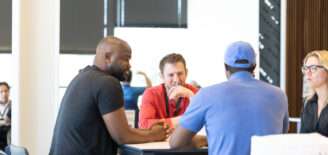DeveloperTown brings startup-style innovation to ‘non-tech,’ established companies
As news of Indiana’s tech boom reaches a fever pitch, there’s a hidden effect that’s gone almost completely unnoticed. Many Indiana companies, even the largest and farthest from the tech scene, are creating software like a startup.
Whether that’s Cummins moving beyond the engine with their digital accelerator, or Republic Airlines investing deeply in making their employee’s lives better and more productive through an app, “non-tech” companies are becoming more and more “tech.”
“Startups and entrepreneurs get all the press and attention. And that’s cool, because we love startups.” says Managing Partner Michael Kelly. “But there are leaders who are doing work inside of companies that’s every bit as innovative as what’s happening in the startup world, and in many cases more impactful — you’ll just never hear about it.”Corporate R&D spending recently increased to $700 billion, and this year healthcare companies will pass computing & electronics companies in R&D spending according to PWC.
Established companies have a lot going for them, like huge product bases, national or international footprints, and budgets with line items that could fund a startup for years. But, building software isn’t core to what they do and if it is, their IT or development team is often fully booked.
“The challenge for most companies is that they didn’t get where they are by building software. And so now, as they try to take a digital approach to solving problems, they find themselves stuck between running the core business and pursuing new opportunities,” says Randy Fisher, a Design Partner at DeveloperTown.The key pain points for companies needing help with their digital tools include not having the right talent, insufficiently available internal resources, or issues with determining where funding for innovative projects should come from.
The result is often a game of innovation or IT musical chairs where digital projects are started, sidetracked, and stopped. Meanwhile, seasoned entrepreneurs and competitors are spending tens of millions of dollars looking for ways to disrupt nearly every industry with new software.
This is where DeveloperTown comes in.
Four years ago, the firm started seeing a sharp increase in large companies wanting help validating, designing, and developing digital ideas quickly. Today, more than 75% of their work comes from these types of companies, many of which are located in Indiana. The company declined to specify its client list but said it’s a wide range of type and size.
“Just as we don’t take a cookie cutter approach to our work, we aren’t committed to a certain industry type, but we’ve been energized by working with companies that have a large impact,” Kelly said.

Asked what advice he would give companies struggling with the question of how much or when to invest in digital tools, Fisher said there may not be a company that doesn’t need to be more technology-enabled.
“When I say technology enabled services I mean the ability for a company to deliver an existing service to its customer that is better, faster, and/or cheaper with the help of technology,” he said. “Take Domino’s Pizza, for example. It recently reinvented itself with a focus on its digital opportunities and its CEO, Patrick Doyle, was recently quoted as saying, “We are as much a tech company as we are a pizza company.”
“There are giant opportunities in looking at your core business through a digital lens. Innovation doesn’t have to be long-shot projects to completely change the way you do business. It’s often as simple as finding new ways to solve existing problems, and that’s where new technology can help,” he said.
Using a “Sprint to Market” process honed over years of working with startups and large companies alike, DeveloperTown helps companies discover, test, and then create software to grow or become more efficient.
Take Republic Airways Holdings, for example. Its flight crews for years would arrive at a destination and need to call a company hotline to learn where their next stop was going to be. Severe weather and high call volumes made this process tedious. It was how they’d always done it, but they knew they needed something new. DeveloperTown designed an app that allows the 4,200+ crew members to access itineraries, flight assignments and lodging — in real time.

DeveloperTown has done similar work for clients ranging from agricultural giants and Fortune 100 pharmaceutical companies to publicly traded companies in the automotive sales sector.
“Typically, our clients fall into two groups, either they’re not a digitally focused organization — think: manufacturing — or they are, but all of their existing IT and development resources are booked on existing projects,” Kelly said. “We love working with leaders in either type of organization who see the opportunity for digital innovation and need help moving like a startup to actually get it done.”
“Sprinting” to market typically involves three stages, although clients may drop in at any point: Discovery & Validation, Design & Build, Launch & Growth.
“The goal for us is to be a guide,” Fisher says. “We want every project to begin with questions and end with confidence in the answer — whether it’s to move forward with a new approach or to realize that first idea won’t work and it’s time to move on to something else.”





